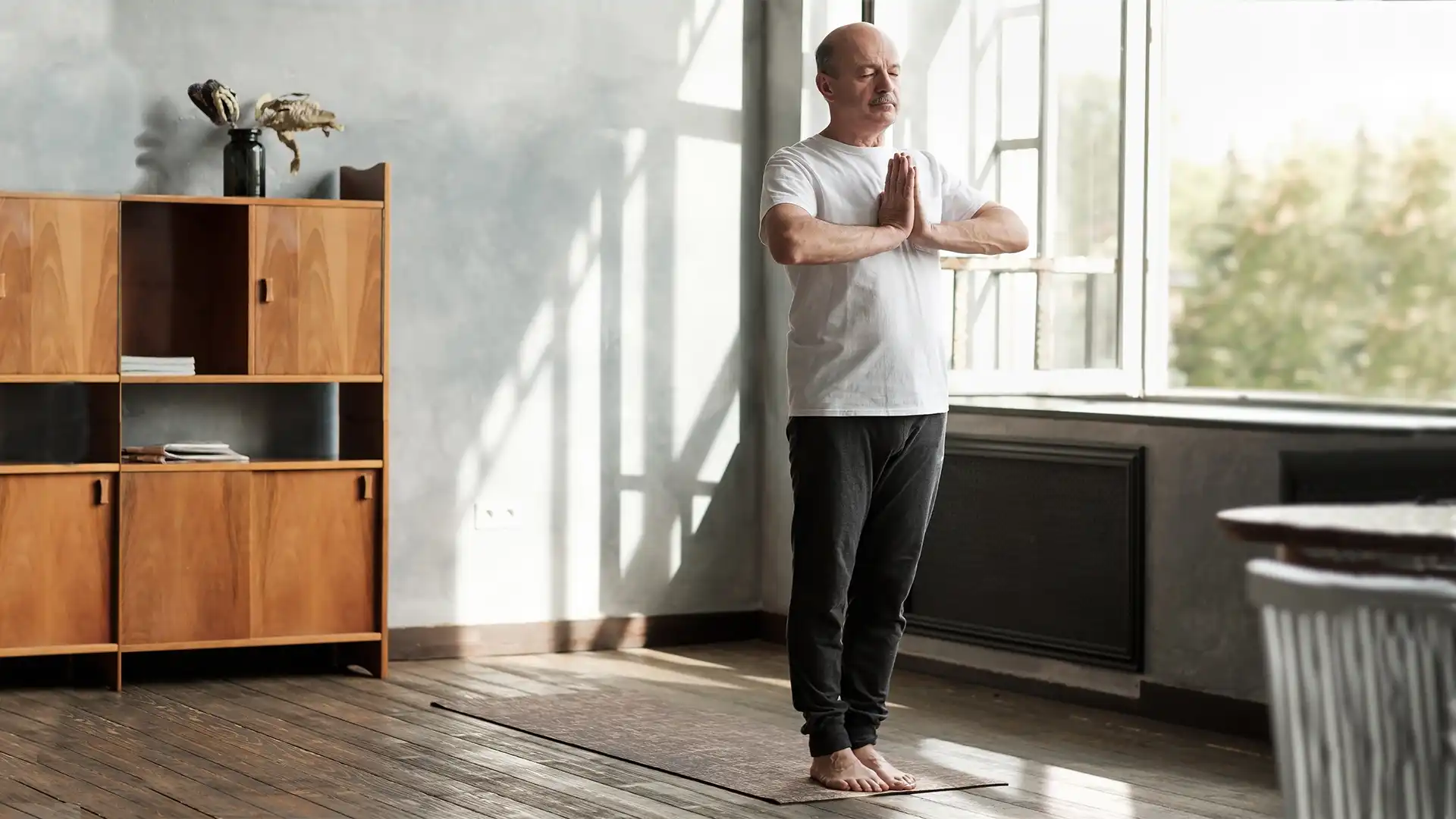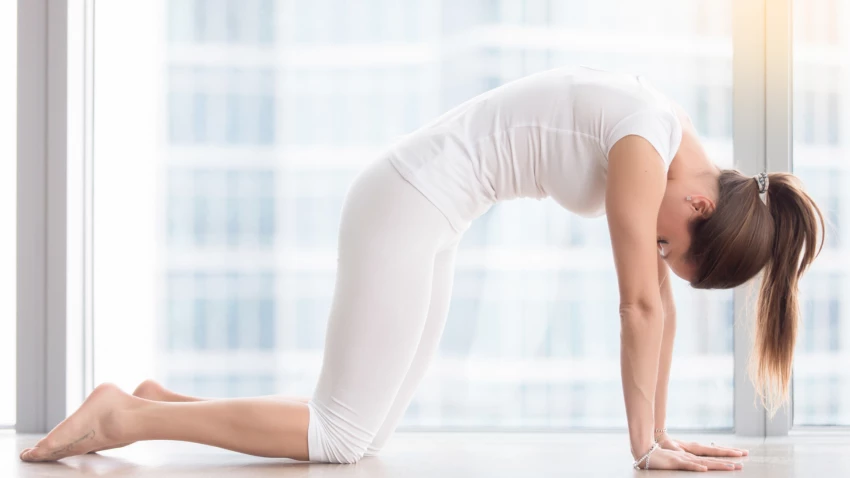Yoga and Scoliosis: Asana Recommendations and the Latest Research

Scoliosis is an abnormal lateral curvature of the spine. According to the American Association of Neurological Surgeons, an estimated two to three percent of the population, six to nine million people, are affected by scoliosis.
Although women are diagnosed with scoliosis seven times more often than men, it does affect both genders. Scoliosis is most often discovered in the teenage years.
Scoliosis in women can worsen at three critical times in a woman’s life: puberty, pregnancy, and perimenopause. The fluctuation of hormones during each of these time periods can cause extra looseness in the joints and less stability in the bones.
Structural vs. Functional Scoliosis
Structural scoliosis results from abnormal development of the muscles and bones of the spine and can’t be easily corrected. Sometimes surgery is necessary if the curve is severe. A yoga practice for someone with structural scoliosis should focus on pain relief and preventing the curve from getting worse.
Functional scoliosis is caused by imbalances in the body. For example, if one leg is shorter than the other, it can cause your pelvis to tilt to one side. Your spine will then try to counterbalance by curving in the opposite direction. Yoga therapy for functional scoliosis should focus on restoring symmetry to the body.
Although scoliosis can develop from a birth defect or trauma, the vast majority of scoliosis is considered to be idiopathic, meaning “no known cause.
Study Suggests Yoga’s Vasisthasana Can Help Scoliosis
Dr. Loren Fishman, YogaUOnline contributor, and presenter, published a study on the effects of practicing Vasisthasana (Side Plank Pose) to improve the scoliosis curve.
Fishman’s study found that performing Side Plank for up to two minutes per day, on the convex, or outward side of the curve, appears to reduce the primary curve.
However, some opponents feel that the asymmetry of Fishman’s study could lead to other injuries or create a further imbalance in the body. Dr. Fishman believes further studies on Side Plank for scoliosis would be beneficial.
A Well-Balanced Yoga Practice for Scoliosis
Whether you have functional or structural scoliosis, a well-balanced yoga practice should strive for muscle balance and symmetry. When designing a yoga practice for scoliosis, pay particular attention to these five areas of your body:
1. Your Feet 
Tadasana (Mountain Pose): Beginning your yoga practice with Mountain Pose is a good way to become grounded onto your mat, as well as play around with the balance between your feet. Notice if you feel more weight on one leg or the other? Do you feel more pressure on the inside or outside of your foot? Make any adjustments to find a sense of balance. Once you feel even in the feet, bring that awareness up to the rest of the body, making any adjustments you feel your body needs.
2. Your Spine (both Symmetrical and Asymmetrical) 
- Marjarasana (Cat/ Cow Pose) will help to warm up and loosen the spine and to prevent injury. Flowing from a flexed spine to an extended spine will help stretch the muscles that support the spine and help to lubricate the vertebrae. (photo right)
- Adho Mukha Svanasana (Downward-Facing Dog): Whether placing your hands on the floor, a wall or a chair, Downward-Facing Dog Pose will help lengthen the erector spinae muscles, which run vertically along the vertebral column. (photo right below)
- Trikonasana (Triangle Pose): Triangle Pose is excellent for improving posture. However, yogis with scoliosis can make a few modifications to help improve both the convex and concave side of the spine.
When practicing with the concave, or hollow side on the upper side of the torso in Trikonasana, place your bottom hand higher onto a chair or stacked blocks. Focus on lengthening the thoracic spine by pushing the chest forward. (photo left)
When practicing Triangle Pose on the convex, or curved side on the upper side of the torso in Trikonasana, place your top hand on your top hip or on your sacrum. Focus on stacking the shoulders. It might feel like you are twisting the upper body to open the shoulders.
3. Your Upper Back and Shoulders
- Garudasana (Eagle Arms Pose): Rounding of the upper back is a common feature of women with scoliosis. Adding the arm portion of Eagle Pose can help to stretch the rhomboids and the trapezius muscles. Focus on encouraging the shoulder blades to move away from the ears and to slide down your back.
4. Your Abdominals
- Vasisthasana (Side Plank Pose): As Fishman’s study suggests, practicing Side Plank on the convex side of your body can help to alleviate the curve. Since practicing solely on one side can lead to overstressing the wrist and shoulder, and further studies are recommended to confirm these findings, a balanced practice could include a set of three side planks; first on the convex side, then the concave side. Finally, another side plank on the convex side to finish the series. (Shown left with the wall for support and forearm variation and also above top).
5. Your Breath
An often important but overlooked by-product of scoliosis is uneven lung capacity. The lung on the concave side can suffer from not getting as much air as the lung on the convex side. A regular pranayama practice can help to stretch the intercostal muscles, open the chest, create deeper and less shallow breathing patterns as well as to increase lung capacity.
Pranayama (Three-Part Breath) is a simple breathing exercise anyone can do.
- Place one hand on your chest and one hand on your belly.
- Begin to take full, deep breaths, first filling your belly with air, then your ribcage, and lastly, your chest.
- On the exhalation, reverse the process expelling air from your chest, your ribs, then your belly.
- Each breath should be a smooth three-count breath.
- Continue this breathing pattern for as long as is comfortable.
A yoga practice for scoliosis takes dedication, a commitment to time, and the awareness of what your body is feeling.
Another helpful asana practice tips article from Jennifer Williams-Fields Restorative Yoga: A Sequence to Build and Maintain Resilience.
Restoring Prana: Key Roles of the Diaphragm in Health and Vitality a course with Robin Rothenberg and YogaUOnline.
 Jennifer Williams-Fields E-RYT 200 is passionate about writing, yoga, traveling, public speaking, and being a fabulous single momma to six super kids. Doing it all at one time, however, is her great struggle. She has been teaching yoga since 2005 and writing since she first picked up a crayon. Although her life is a sort of organized chaos, she loves every minute of the craziness and is grateful for all she’s learned along the way. Her first book, “Creating A Joyful Life: The Lessons I Learned From Yoga and My Mom” is now available on Amazon. She has had her essays featured on Yahoo! and Dr. Oz The Good Life. She is a regular writer for Elephant Journal Magazine, Your Tango and YogaUOnline. See more from Jennifer at jenniferwilliamsfields.com.
Jennifer Williams-Fields E-RYT 200 is passionate about writing, yoga, traveling, public speaking, and being a fabulous single momma to six super kids. Doing it all at one time, however, is her great struggle. She has been teaching yoga since 2005 and writing since she first picked up a crayon. Although her life is a sort of organized chaos, she loves every minute of the craziness and is grateful for all she’s learned along the way. Her first book, “Creating A Joyful Life: The Lessons I Learned From Yoga and My Mom” is now available on Amazon. She has had her essays featured on Yahoo! and Dr. Oz The Good Life. She is a regular writer for Elephant Journal Magazine, Your Tango and YogaUOnline. See more from Jennifer at jenniferwilliamsfields.com.



